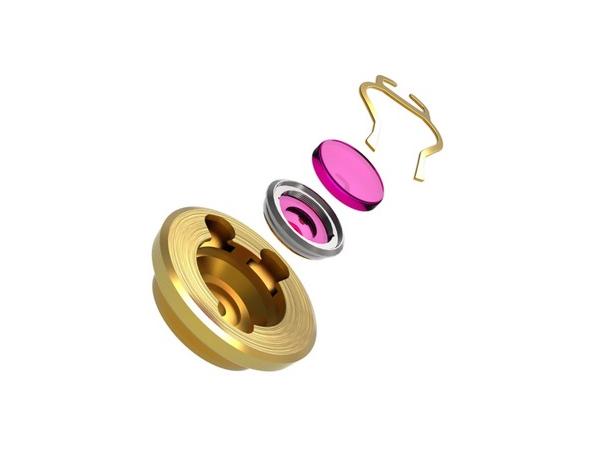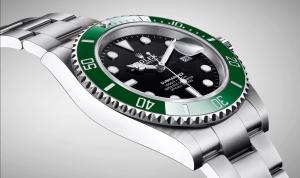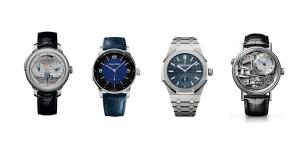What are Watch Jewels: A Complete Guide

Watch jewels are vital parts of a mechanical timepiece. In fact, serious watch collectors check how many jewels a movement has before making a purchase. However, there are some who simply don’t pay attention to this detail. Either way, watch jewels are indispensable, especially for mechanical movements. But what purpose do they really serve? Do these parts necessarily change the value of a timepiece? Read on to find out.
What are watch jewels?
Watch jewels, jewel bearings, or simply jewels can be found within a watch’s movement. They’re described as tiny synthetic ruby or sapphire pieces set into the holes of the movement.
We all know mechanical watches do not require batteries to function. Instead, they use a spring-wound mechanism to run. The function of the watch jewels is to aid this process. A movement is a complicated assemblage of various little parts such as gears and springs. These parts help the movement move, rotate, and, at the end of the process, help the hands of the watch tick. Most of the high-end, self-winding, and hand-wound watches in the market, then and now, have bearings made out of jewels. Thus, the jewel bearings. Because these bearings are made of precious stones, their smoothness aids in keeping friction from getting in the way of energy production of a movement. Each bearing makes the gears turn smoothly.
Back in the day, watch jewels are made of actual precious gems such as a ruby. Before that, manufacturers employed the help of quartz, glass, or garnet in the process. So, yes, historically watch jewels are, indeed, made of precious stones! However, as time and technology allowed, a few innovations managed to cut down a lot of costs for movement manufacturers. A lot of manufactures recently adopted the use of synthetic rubies and sapphires, lab-created not only for a more convenient and cost-efficient source but also for more ethical reasons as well.
These jewels — synthetic or not — provide the same function. They all act as bearings to make the watch move more efficiently and keep it from wearing down easily. Jewels allow metal components to rotate freely for a more accurate and durable movement. In short, the jewels help make the movement last longer than it had ever been before.
What are the types of watch jewels?
You’d think that jewels are one-type-fits-all. However, they can be more complicated than that. Bearings have four different types that can be found in modern-day movements: cap, hole, pallet, and roller jewels.
Hole Jewels

Pierced jewels, also popularly known as hole jewels, can easily be spotted due to the hole right in it. This hole is placed strategically to allow mounting right on the wheel’s axle or pivots, whether cylindrical or conical. Most of the time, hole jewels have a slightly rounded top side, while its bottom part is flat. If paired with a cap jewel (or capstones), they make up a set referred to as a pivot bearing. Together, they make the axle spin. On the other hand, when placed on the balance staff, they make an anti-shock part, held in place by springs for optimal shock absorption.
Cap Jewels

Cap jewels, also known as end stones or capstones, work just as the others do. However, they require a second or outer jewel that sits at the tip of the gear shaft. This results in a few functional effects. Firstly, it ensures lubrication for fast-moving parts like the balance wheel. This is done by forming a small oil reservoir between the two jewels. This type of bearing also keeps the shoulders of the arbour from rubbing against the jewels. This is made possible through the conical shape of the shaft due to the jewel’s formation. If the shoulders of the arbour rubbed against the jewels, it can greatly impact the accuracy of the watch. Moreover, capstones also keep the arbour from moving unnecessarily up and down during rotation.
Pallet Jewels

As its name suggests, the pallet jewels have a pretty straightforward function. They can be described as rectangular jewels. Pallet jewels can also be found at the end of each of the arms of a pallet fork.
Roller Jewels

Now, to connect the escape wheel and the pallets in a watch’s movement, a roller wheel comes into the scene. It serves as a conjunction point between the two. Roller jewels usually have a caved upper side while its lower side is flat. They are usually found inside the pallet fork of a movement.
How many jewels do watches have?
There’s no specific answer for this. However, most watch movements have 17 jewels. At that point, a watch can already be considered fully jewelled. But as a rule of thumb, the more complications a movement has, the more jewels it should have. A movement with 17 jewels has the following usage in various areas of a movement:
- One impulse jewel is found in the balance wheel, right where the escapement level hits the assembly.
- Two hole jewel and two cap jewels — a total of two pairs — function as pivot bearings for the staff pivot, giving it a total of four jewels.
- One hole jewel and one cap jewel form as a pivot bearing on the centre wheel, a total of two jewels.
- Two pallet jewels can be found on the escape level pallet.
- One hole jewel and one cap jewel function as a pivot bearing at the escape level for a total of two jewels.
- A hole jewel and one cap jewel also work as a pivot bearing on the escape wheel for a total of two jewels.
- One hole jewel and one cap jewel at the third wheel work collectively as a pivot bearing, giving it a total of two jewels.
- At the fourth wheel, one hole jewel and one cap jewel form as a pivot bearing, a total of two jewels.
Other watch movements have 21 jewels, and they don’t differ much from the settings of a 17-jewel movement. Having 21 jewels only usually means that it has more cap jewels or capstones to keep the jewels from moving and for a more efficient function. Extra capstones can usually be seen on high-quality timepieces.
Do more watch jewels mean better movement?
There are two sides to this. Before anything else, we must keep in mind that watch jewels aren’t just accessories. Despite what they’re called, jewels serve actual functions, just as any part of a watch does. One must remember their aforementioned function, and that is to minimise the friction between the mechanical parts of a watch. This, in turn, protects the movement’s components and helps it last longer, keeping it from getting worn out easily.
And as you know, more complications mean more parts. Therefore, it only makes sense that it has more jewels. By complicated watches, we mean watches such as a perpetual calendar watch, a tourbillon, or a chronograph. There are other features that make a watch complicated such as dual time or GMT, or even power reserve indicators, as well as moon phases. Name an extra feature on a watch and it will fall into that category. We’ve seen a lot of watches that have multiple complications in them such as a perpetual calendar with a moon phase included. These don’t just function as usual with 17 or so jewels. The more complicated a watch gets, the more jewels it requires for more lubrication and less friction when moving.
Complicated watches don’t only fall on high-end or luxury watch brands such as Patek Philippe, Rolex, or Omega. A lot of them can also be found in mid-tier and even entry-level watches. Therefore, the number of jewels doesn’t necessarily indicate that its movement is a lot better than the others. If anything, the number of watch jewels in a movement only shows how complicated or intrinsically engineered a mechanical movement is. In some cases, more jewels also mean thinner movements, therefore, thinner watches. So, if you ask us, the answer is no.
The Watch with 242 Jewels

Not to mention, jewels in a watch doesn’t always go by two digits. So, it wouldn’t be easy to keep track of its jewels every single time. In fact, the world’s most complicated watch has 242 jewels in its movement. It’s the Ref. 57260 from Vacheron Constantin, with a whopping 57 complications. Having 2,800 components, it only makes sense that its jewels also exceed in number.
To tell you how complicated this watch is, here’s a quick rundown of its functions. It has 6 functions for time, 7 perpetual calendar functions, 8 Hebrew calendar functions, 9 astronomical calendar functions, a lunar calendar, a religious calendar, 4 chronograph functions with 3 column wheels for each, 7 alarms, and 8 Westminster carillon striking function. It also has a power reserve indicator, a power reserve indicator for the striking train, a crown position indicator to easily verify the mode it is on, dual-barrel winding, a time setting that lets two positions and directions function, as well as a secret mechanism to wind the striking train. At $5 million, it sure seems aptly priced.
Do jewels determine a watch’s value?
And now, to the most important questions: do jewels actually determine a watch’s value? The quickest answer is no and it rests on various factors. Among those include the fact that the jewels in a watch are actually man-made gems. They’re not natural rubies or sapphires that would cost a lot more especially if used for fine jewellery like a necklace, bracelet, or even to crust a timepiece. So, no, more jewels don’t mean your watch is more expensive, but they surely help in making the movement more reliable.
Do quartz movements have jewels?
While quartz movements also have moving parts similar to mechanical watches, it’s worth noting that not all quartz movements use watch jewels.
Examples of Jewels in Watches
To further give you an idea about watch jewels, let’s take a closer look at movements from various manufacturers — from ETA to Miyota.
ETA Calibre 2824-2

The ETA Calibre 2824-2 proves to be one of the most popular movements in the industry. It went into production in 1982 and remains in the market since. The calibre is mostly based on the original Eterna calibre 1427 with the suffix “-2” indicating the generation of the movement. This chronometer movement has 17, 21, or 25 jewels. Branded movements such as the Glycine Calibre GL224 are based on this movement and have 25 jewels. Meanwhile, the Frederique Constant Calibre FC-303 — also based on the ETA Calibre 2824-2 — has 26 jewels. On the other hand, the Ball Watch Calibre 2050 has a whopping 49 jewels!
Miyota Calibre 9015

As a workhorse movement, the Calibre 9015 from Miyota has proven itself a powerful movement. With 24 jewels, this automatic movement came straight from Japan, introduced in 2009. A lot of microbrands such as Zelos Helmsman and Marc & Sons use this movement because it’s easy to obtain and features a good hacking function.
Rolex Calibre 4130

Released in 2000, the Rolex Calibre 4130 has 201 total parts. With that, it has 44 jewels to ensure its smooth function. This movement powers the Rolex Cosmograph Daytona that used to work with a Zenith chronograph movement. Among its functions include a chronograph, as well as a tachymetric bezel. It’s also a certified chronometer by COSC.
Final Thoughts
Watch jewels can be a complicated topic in itself. Most of their value rests on the functions and aide they provide the movement. However, it can be easy to grasp how jewels are important to some collectors. They definitely insure that a timepiece works perfectly smooth and even preserves its lifespan as necessary. While more jewels don’t necessarily indicate a watch’s value, they surely keep a complicated movement in perfect shape. And the more stable your movement is, the more accurate it can be. We can’t blame certain collectors for keeping an eye out on how many jewels a certain timepiece has. But it should be kept in mind that these are not actual rubies and sapphires on your movement. They are synthetic, so be cautious when approaching the jewel territory. Don’t be fooled by the fact that certain timepieces have more jewels than the other.
At the end of the day, what you have to look for in a watch should always be accuracy and function. If your timepiece is extremely accurate (COSC-certified even), then you’d completely ignore the number of jewels it has. Moreover, if it provides you with the right functions for your needs, then the number of jewels shouldn’t even matter.
Want to learn more about high-quality watches? Check out our guide on COSC and chronometer certification!


